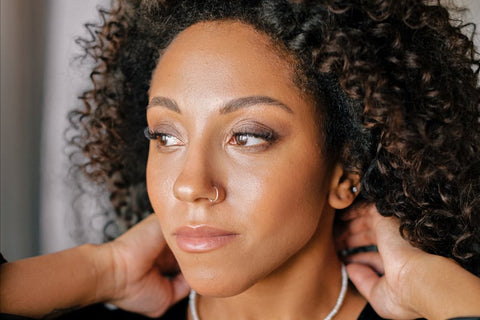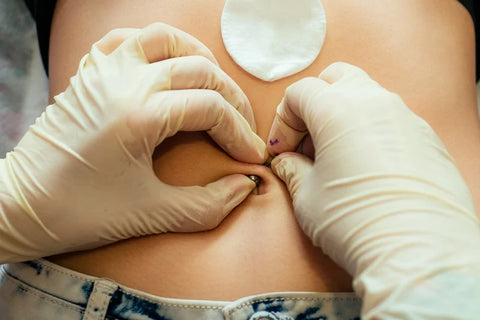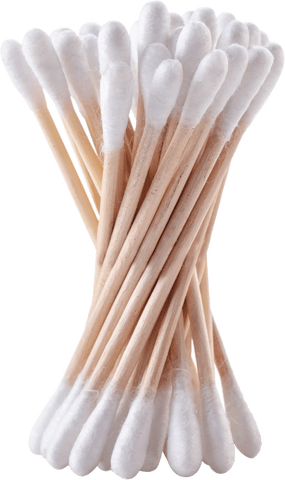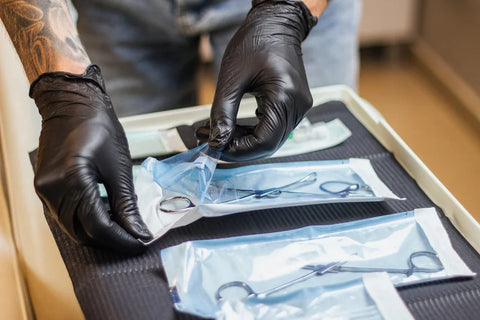The golden rule: don't touch your piercing!
You probably already know this, but it's always good to remember it before anything else.
If you constantly handle your piercing you expose yourself to the risk of infection, since hands carry many bacteria.
So be careful: only touch your piercing when necessary, for example during treatment.
Our advice:
- Avoid any blows or direct contact with the piercing (such as hairbrushes, headphones or earphones, etc.)
- Be careful about the products you use that could come into contact with your piercing, such as colored shampoos or anti-lice products, for example. Use a gentle shampoo without harsh products. Also avoid products containing alcohol or strong perfumes, or overly powerful antiseptic solutions.
- Pay attention to the quality and material of the piercings you put in.
- Be sure to protect your piercings during sports activities by wearing loose-fitting clothing that won't rub against the piercing. You can opt for headwear, headbands, or bandages specially designed to protect your piercing.
- At first, do not go to areas with a high risk of bacterial contamination such as baths, saunas, steam rooms, or UV cabins, as these places can potentially cause an infection.
- Don't sleep on your piercing: Ideally, you shouldn't lean on your piercing while sleeping, especially in the early stages. If you have a new ear piercing, for example, it's best to sleep on the opposite side or on your back.

During healing:
To ensure proper healing of your piercings, it is strongly recommended not to turn your jewelry. It is also preferable not to change your piercing jewelry too early. The piercer will recommend a minimum amount of time before changing your jewelry. You can also return to see him to make your change, this will be the opportunity to see if your piercing is healing well and he will know how to put in your new jewelry (which is not easy to do yourself depending on the location!).

Avoid removing the scabs (even if it's tempting)!
We've all felt the urge to remove the scabs forming around our piercings when we see them. However, this reflex should be avoided to ensure optimal healing of your piercing.Scabs have a protective role as they provide a natural shield of protection against external elements and prevent potential infections, making them essential in the healing process.
Removing them can therefore both prolong the healing process and cause inflammation or infection, which compromises the health of your piercing. By allowing the scabs to follow their natural cycle, you promote uncomplicated healing.
Namely: the self-healing process
As you know, the healing process of a piercing isn't always easy. The body is programmed to heal itself and repair damaged tissue naturally. If you disrupt this process too much, the healing time will be prolonged. Adopt a proper cleansing method and only clean as needed.
Find here the healing times for each piercing . This information is given to you for information purposes only and depends on each individual, their genetics, their medical history, etc. Healing times can be longer or, on the contrary, very fast.
Wash your hands!
Before touching your piercing, be sure to wash your hands thoroughly with soap and clean water to avoid transferring bacteria to your piercing that could later cause an infection. Doing this daily will help prevent complications that could make your piercing experience less enjoyable.The key steps to disinfecting your piercing
To effectively disinfect your piercing, here are the steps to follow:
Wash your hands : Before touching a piercing, it's essential to wash your hands thoroughly with soap and warm water for at least 20 seconds to remove any germs on your skin. This prevents bacteria from getting into your piercing.
Use a saline solution or pH-neutral soap : Apply a saline solution recommended by your piercer or healthcare professional to a sterile cotton swab or gauze pad. Gently clean the area around the piercing, removing only the largest debris and impurities to avoid hindering the healing process. Be careful not to scrub too hard to avoid irritating the skin. You can repeat this process morning and night. Above all, do not use alcohol or hydrogen peroxide, as these can be too harsh for the skin.
Rinse with clean water : Once you have cleaned the piercing, rinse thoroughly with clean water to remove all traces of the solution used, and thus avoid any signs of irritation.
Dry gently : Use a clean towel or sterile gauze pad to gently dry the area around the piercing. Do not rub, and make sure the area is completely dry, as a wet piercing cannot heal properly.

Potential infections:
Why does the piercing get infected?
A piercing doesn't get infected without a reason. If your piercer performs the piercing properly and with all the necessary hygiene precautions, there's very little chance of it causing an infection.
Most often, it's us who cause an infectious reaction, especially because of our hands! To avoid this, it's absolutely necessary to follow the precautions and care given by your piercer.
What are the signs of an infection?
Important: Do not confuse infections with inflammation/irritation. These reactions are normal and are an integral part of the healing process. In most cases, you will not experience infections, but only irritation from your recent piercing.
Therefore, monitoring this healing process is crucial to detect any early signs of infection and take prompt action to preserve your health and that of your piercing.
Signs of early infection:
- Red fabrics
- Swelling around the piercing
- Pus discharge near your piercing
- Heat around your piercing
- Continuous pain for a significant period of time
Do you think you have the beginnings of an infection?
Don't panic, the first thing to do is stay calm and don't touch your piercing.What to do :
- Contact your piercing professional who will be able to guide you in treating the infection.
- Consult a doctor
- Do not attempt to remove your piercing, as this could introduce more bacteria and compromise the treatment of your infection and therefore the final healing of the piercing.

In our next article, we will explain the process for treating your piercing infection.



